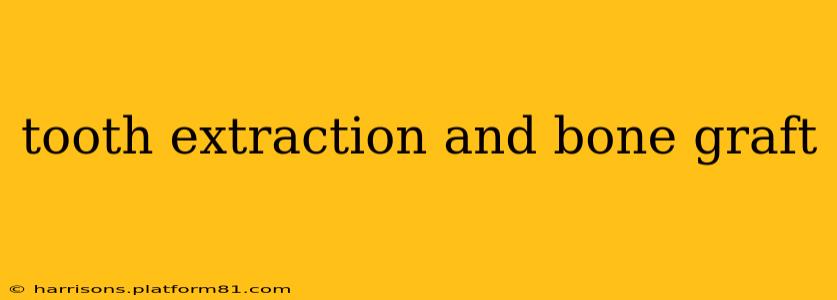Losing a tooth can be a distressing experience, but advancements in dentistry offer effective solutions to restore both your smile and oral health. One common procedure involves tooth extraction followed by a bone graft. This guide provides a comprehensive overview of this process, addressing common questions and concerns.
What is a Tooth Extraction?
A tooth extraction is the surgical removal of a tooth from its socket in the jawbone. This procedure is often necessary for various reasons, including severe tooth decay, infection, periodontal disease (gum disease), impacted wisdom teeth, or injury. The process itself varies depending on the complexity of the extraction. Simple extractions involve removing a tooth that's visible above the gum line, while surgical extractions may be required for teeth that are broken, impacted, or deeply rooted.
What is a Bone Graft?
A bone graft is a surgical procedure where bone tissue is transplanted to a specific area to stimulate bone regeneration. Following a tooth extraction, the jawbone can begin to resorb (break down) over time, especially if the tooth isn't replaced promptly. This bone loss can affect the stability and success of future dental implants or other restorative treatments. A bone graft helps to prevent this bone loss, providing a stronger foundation for future procedures.
Why is a Bone Graft Necessary After a Tooth Extraction?
Bone grafting after tooth extraction is crucial for several reasons:
- Preservation of Jawbone: The jawbone needs stimulation to remain healthy and strong. Without a tooth root to stimulate it, the bone can resorb, leading to facial changes and making it difficult to place dental implants later.
- Successful Implant Placement: Dental implants require sufficient bone volume for stability and long-term success. A bone graft ensures there’s enough bone for a secure implant placement.
- Improved Aesthetics: Bone loss can lead to a sunken or altered facial appearance. A bone graft helps maintain facial structure and aesthetics.
What are the Different Types of Bone Grafts?
Several types of bone grafts are available, each with its own advantages and disadvantages:
- Autograft: Bone is taken from another site in the patient's body (often the chin or hip). It has a high success rate as it's the patient's own bone, but requires a second surgical site.
- Allograft: Bone is taken from a donor. It's readily available but carries a slightly higher risk of rejection.
- Xenograft: Bone is sourced from an animal, usually a cow. It's less expensive than other options but may have a lower success rate.
- Alloplast: Synthetic bone substitutes are used. These materials are biocompatible and stimulate bone growth.
What Happens During a Tooth Extraction and Bone Graft Procedure?
The procedure generally involves local anesthesia, allowing the patient to remain awake and comfortable. First, the tooth is extracted. Then, the extraction site is carefully prepared to receive the bone graft material. The graft is placed into the socket, often stabilized with sutures. The entire process usually takes a few hours, depending on the complexity of the case.
What is the Recovery Process Like After a Tooth Extraction and Bone Graft?
Recovery involves pain management, regular oral hygiene, and following the dentist's post-operative instructions. Some swelling, bruising, and discomfort are expected, and pain medication can help manage these symptoms. The healing time varies depending on the type of graft and individual healing capacity. Regular follow-up appointments with the dentist are essential to monitor the healing process and ensure the graft is integrating properly.
How Much Does a Tooth Extraction and Bone Graft Cost?
The cost of a tooth extraction and bone graft varies greatly depending on several factors, including the complexity of the extraction, the type of bone graft used, the location of the dental practice, and the patient's insurance coverage. It's best to consult with your dentist to get a personalized cost estimate.
What are the Risks and Complications Associated with Tooth Extraction and Bone Graft?
As with any surgical procedure, there are potential risks and complications, although they are relatively rare. These may include infection, excessive bleeding, nerve damage, sinus complications (in the upper jaw), or graft failure. Your dentist will discuss these risks in detail during your consultation.
How Long Does it Take for the Bone Graft to Heal?
Healing times vary. Generally, initial healing takes several months, with complete bone integration taking up to a year or more. The dentist will monitor progress through regular checkups.
Can I Get a Dental Implant After a Bone Graft?
Yes, bone grafting is frequently done to prepare the jawbone for a dental implant. However, there will typically be a waiting period to allow for proper bone integration before the implant can be placed. Your dentist will determine the appropriate timing.
This information is for general knowledge and does not constitute medical advice. Always consult with a qualified dental professional for diagnosis and treatment planning. Remember, maintaining good oral hygiene is key to preventing tooth loss and related complications.
